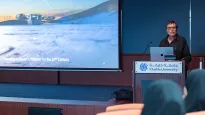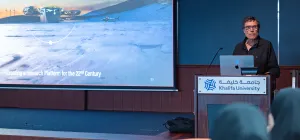RECTO: Refugia & Ecosystem Tolerance in the Southern Ocean

Henri Robert is busy in Antarctica conducting the first ever bird population assessment in the Sor Rondane Mountains near Princess Elisabeth research station
Background
Current global changes are quickly affecting our planet, and parts of Antarctica are among the fastest warming regions of the world while the Southern Ocean is also further endangered by ocean acidification. Having undergone historic climatic changes, the Snow Petrel is a circumpolar Antarctic and Sub-Antarctic seabird which serves as a perfect model organism to predict future global change scenarios. However, the evolutionary history and taxonomic status of this seabird is the subject of considerable controversy. The current consensus is that there are two distinct subspecies, the lesser and the greater Snow Petrel (respectively P. nivea nivea and P. n. major) which could be the result of different glacial refugia and the establishment of post glacial hybridization zones.
RECTO Project (BELSPO)
As one of the target species of the BELSPO-RECTO project, the beautiful and graceful Snow Petrel (Pagodroma nivea s.l.) is now capturing all of Henri Robert’s attention during the 2017-2018 BELARE campaign. The Snow Petrel is the most common species of the inland Queen Maud Land (the station and colonies are located nearly 200 km from the coast). Henri is not only doing a population assessment, but also a genetic assessment of the species in an attempt to reconstruct its evolutionary history and phylogeography. He will predict future distributions of the Snow Petrel and its prey under different scenarios by integrating spatial and trait distribution models with state-of-the art models for ocean dynamics, prey availability and sea ice.
The RECTO project will link the Snow Petrel's population history and refugia to past climate changes events. Biometrical variation (bill, tarsus, wing and tail length) will be measured and used to assess morphological variance among populations located around the Antarctic continent and Sub-Antarctic islands. Molecular techniques will be used to untangle the complex genetic structures of these birds, reveal population expansions, bottlenecks and population connectivity. Other studies will also allow for reconstruction of the phylogeography of the two “subspecies” occurring today.
In Action at Princess Elisabeth
Soon after arriving at Princess Elisabeth research station, Henri began work at the different study sites. The planning is ambicious: during one short season the objective is to monitor all breeding sites of Snow Petrel (Pagodroma nivea s.l.) of the Eastern Sor Rondane, perform a primary population estimate of the area and collect DNA samples.
Every day with his guide, equipped with polar clothes, shoes studs and ice axe, Henri is systematically surveying the rocky slopes of each nunatak where Petrels are known to breed. Each nest will be geo-referenced and local population estimated based on the number of occupied cavities.
Working conditions have been favourable so far, only two days of storm and poor visibility in late November. Most of the time, however, the sun is shining through clear blue skies and the wind is relatively calm. Temperature varies between -5°C and -20°C (with some season's unusual peak of 0°C on the brightest sunny days).
Stay tuned for more news on Henri's Snow Petrel work at Princess Elisabeth.
Henri Robert
Henri Robert is a biologist with the Conservation Biology Unit (OD Nature) of the Royal Belgian Institute of Natural Sciences (RBINS). Henri began his career as a field assistant for several conservation and research programmes across the world, focusing mainly on birds. For twelve years, he worked in the Carcinology Laboratory of RBINS on taxonomy of Southern Ocean amphipods. It was during this period where he took part in several missions on research vessels that he developed a passion for polar environments. As a keen ornithologist with an equal passion for marine mammals he then joined the Conservation Biology Unit with an insatiable curiosity for the Southern Ocean and its wildlife. In collaboration with the Laboratory of Polar Ecology (PolE) he participated in several missions along the Scotia Arc, the Antarctic Peninsula, the Weddell Sea and the high Arctic Ocean to perform long term “top predators” (marine mammal and seabird) monitoring. Other research and wildlife conservation programs has led Henri to work in the remotest tropical forests of the Congo basin (Central Africa) as well as Pacific Ocean to explore the invertebrate communities. While gathering data for the Census of Antarctic Marine Life (CAML) he had the opportunity to take part in the 2008-2009 BELARE campaign where local bird populations (Snow Petrel mainly) caught his attention and persuaded him to return to Princess Elisabeth Antarctica research station nearly a decade later to further investigate these emblematic and little known birds.
A series of short reports will soon be available on: www.naturalsciences.be/en/news and www.instagram.com/rbinsmuseum/
Download





















